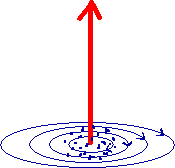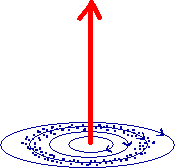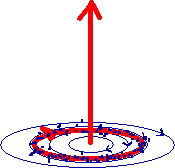1. IONS PUSHED TO ONE SIDE OF THE STALK
3. BOL'S IN VERTICAL MOTION - THE LORENTZ FORCE
4. BOL'S IN VERTICAL MOTION - PART 2
5. THE SUPERBOL AND ALTERNATING CURRENTS
11. BOL's OF MAGNETIC DUST
13. MAGNETIC DUST SUCKED IN AND SPRAYED OUT
Somewhere in the loose earth of the soil between the stalks, plowed under in earlier times, is an amount of electric conducting magnetic dust. (Fig. 11.1)
![]()
 Fig. 11.1
Fig. 11.1
Magnetic dust tries to maintain acquired shape. So when the dust is laid on a heap it would resist forming a circle. To lay the dust in a circle is laborious. So it suits the best when the loose earth allows the magnetic dust to be drawn out of the soil. (Except at the stamped earth of the tram lines. Is this why there is sometimes a curtain of standing crop skirting the tram line? Did anyone ever try to analyze tram line soil at the intersection with a formation?)
After a certain time an earth current comes out the earth and invades the air, just from under the dust. Necessarily the earthcurrent is immediately accompanied by its magnetic field. (Fig. 11.2)

 Fig. 11.2
Fig. 11.2
So the conductivity of the air must have been enhanced there, maybe by some special kind of dust suspended in the air. The same kind of dust as in the loose earth? Then the dust directs itself along a magnetic field line, just like beads threaded on a string. (Fig. 11.3)

 Fig. 11.3
Fig. 11.3

When the dust particles form a closed ring (no gaps) then by induction electric current goes from the earth current to the circle of magnetic dust. A circlecurrent has formed, a BoL is born! (Fig 11.4)

 Fig. 11.4
Fig. 11.4
This seems easier with smaller rings that need lesser magnetic particles. If so then smaller BoL's are more abundant than the bigger ones.